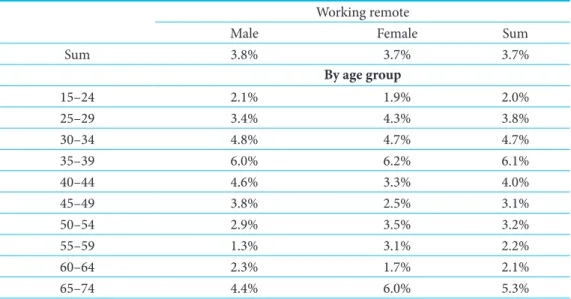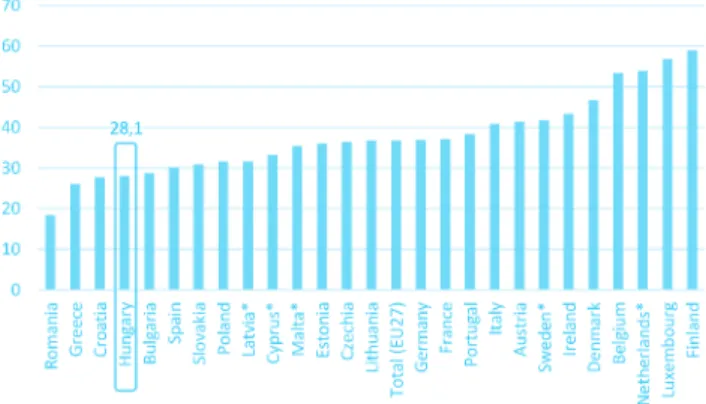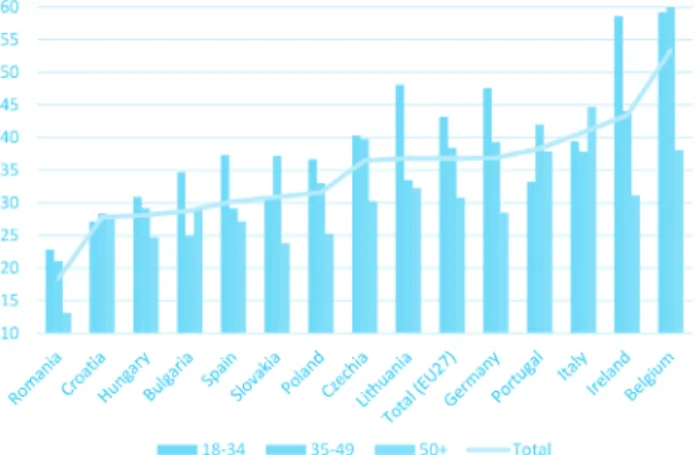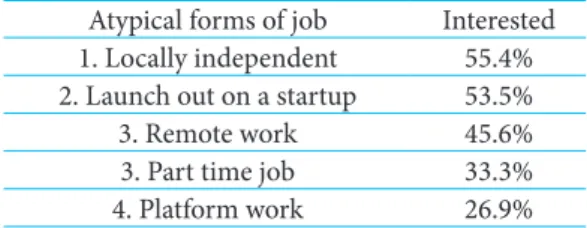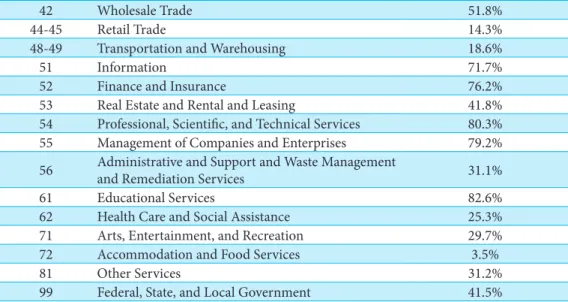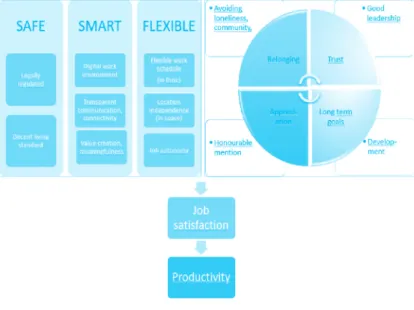ILONA CSERHÁTI 1
“Business is unusual”
– remote work after COVID-19
During the recent pandemic millions started to work from home. One of the main questions is that this revolutionary change becomes permanent (i.e. remote work will be the new nor- mal) or it will be just a temporary one. In case that remote work is here to stay, it is essential to analyse whether this new form of work makes employees more satisfied with their jobs or not. It is frequently argued that happy workers are more productive, but a generally accepted methodology for measuring both job satisfaction and its possible drivers would be essential to prove this relationship quantitatively. The paper gives a brief overview of the latest trends and tendencies regarding remote work, with special regard to the newly remote workers who have transitioned to remote work after COVID-19 outbreak. The paper explores possible advantages, unavoidable drawbacks and expected challenges of remote work, outlining the prerequisites for implementing remote strategies successfully. Finally, a theoretical model for determining the main drivers of job satisfaction are presented.
Introduction
What makes you happy at the workplace and whether these drivers are expected to change in the near future? Could it be argued based on quantitative evidence that productivity would increase as a consequence of higher level of job satisfaction? If this hypothesis can be verified and the relationship is proved to be significantly positive (irrespectively of time and country) then it would be of crucial importance for economists, employers and governments to determine the actual main drivers of employee wellbeing. The fact that more and more people seek self- fulfilment not only in their personal life but also in their professional carrier changes the expectations towards an “ideal workplace” and an “ideal job”.
This paper focuses on finding the main drivers of employee wellbeing in Hungary with special regard to the recent huge changes in size and structure of remote work due to the pandemic. The structure of the paper as follows. In section II a literature review is given regarding remote work, in section III official and survey datasets are presented for analysing the stance of remote work before the outbreak of the pandemic, in section IV the huge changes are shown due to the global spread of COVID-19, while in section V the expected impact of this rapid shift is analysed for the “after COVID-19” period and possible drivers of job satisfaction are highlighted. Finally, in section VI some conclusions are drawn and some further research plans are presented.
1 Associate professor,Department of Statistics, Corvinus University of Budapest DOI: 10.14267/RETP2020.02.04
Literature review
Olson (1983) raised a question of a new phenomenon, namely remote office work or telework.
She projected in 1983 that the office automation technology would change the way we work, i.e. many office workers would become potential telecommuters. The employees (who had already worked from home) were found to be highly self-motivated and self-disciplined. Olson suggested organizations to give more options in space and time to their employees to get increased motivation and productivity.
Bell (2012) took part in a remote work research project through the Cornell Center for Advanced Human Resource Studies (CAHRS) in the ILR School at Cornell University. In the research interviews were conducted with nine CAHRS partner companies (including Aetna, Citigroup, Cisco Systems, General Mills, and IBM) in order to identify the strategies and practices companies have developed to manage their remote workers. The main findings of this research were the followings:
– senior leadership support is proved to be essential for cultural acceptance of remote work, – personal and professional isolation is a higher risk since less face-to-face interaction occurs, – only high quality direct leadership can lead to a better performance of remote employees
and to a higher level of job satisfaction.
IBM (2014) had a research (about remote working from the full-time employee perspective.
They had some findings:
The numbers teleworking at least one day per week have remained remarkably consistent for Anglo countries between 2008 and 2013 at around 9 percent. Australia had a 2 percentage point jump in 2013, the largest increase in group of Anglo countries.
– The higher up the career ladder, the more likely you are to telework.
– Workers in the high-tech industry are more than three times as likely to telework as those in the government.
– Teleworkers are more highly engaged, more likely to consider their workplaces as innovative, happier about their job prospects and less stressed than their more traditional, office-bound colleagues. One of the most commonly discussed benefits of flexible work arrangements is the better work-life balance.
– Remote work is not suitable for every type of job; construction workers will likely always need to be on the construction site and retail associates in their stores. However, a lot of jobs are suitable for remote work and in future, the number of remote workplace will likely continue to increase.
– Poorly prepared managers do not promote often the remote work. Training organized them how to manage and lead remote employees is important to overcome barriers of the success of teleworking. Leadership needs to actively create an organizational culture that supports telework.
Fernandez and Marrauld (2017) analysed the design of a virtualized platform and focused also on the remote working management. They proposed three options:
– The remote worker works exclusive at home, uses a desk in its flat. His or her work is under control by the ICT (information and communication technology) because instant massages allow the verification that the home workers are really behind the computer.
– The remote worker works sometimes at home. The ITCs allows one to contact them at any time even he/she is not available.
– The remote worker works in a co-working space or telecentre: he/she has a high degree of autonomy of organizing of his/her work
Felsted-Golo (2017) found some evidence of remote work based on statistical data. The data of Labour Force Survey (LFS) and Skills Surveys of United Kingdom replicate that remote working has been growing among 20-59 year olds who are in work. The proportion working at least one day a week away from the conventional workplace grew by 4 percentage points from 13.3% in 1997 to 17.1% in 2014.
According to Olubunmi et. al (2017), ”migration in the twenty-first century is the movement of mindpower, not simply bodies”. The World Economic Forum’s Global Future Council on the Future of Migration has a project, namely Mobile Minds. The aim of the project is to promote global prosperity to support global remote work. The authors recognize that a globalized world requires a globalized labour market, and that the coming decades will only bring more need for solutions like remote work.
Expected benefits of remote work for employers the real estate cost savings and the improved worker productivity mainly as a consequence of fewer distractions from colleagues, a quieter work environment and no commuting time. They state that remote work could have positive impacts also on the whole society by reducing unemployment in economically underdeveloped areas, improving gender equity, decreasing the environmental footprint.
Choudhury et al. (2019) analyse the effects of the WFA (”work-from-anywhere”) program on productivity of at the United States Patent and Trademark Office. While traditional “work-from- home (WFH)” programs offer the worker temporal flexibility, “work-from-anywhere (WFA)”
programs offer both temporal and geographic flexibility. The authors found that the output under WFA increased a 4.4% in comparison to WFH. The provided evidence also that WFA examiners relocate to lower cost-of-living conditions.
Stance of remote work before COVID-19
Remote work before COVID-19: a global view
A relatively large scale international survey was conducted by Zapier (2019) (a fully distributed team of 300 employees working from 27 countries) asking nearly 2,500 remote workers to get their opinion and experience about the benefits and struggles that come with remote work and also get some information on the structure of their remote companies. Almost half of respondents (1180 people) lived in the United States, followed by Canada and United Kingdom (6-6%). This survey was conducted online among remote workers of age 18 and older who primarily used the computer for doing the job can be considered as knowledge workers.
The main conclusions were as follows.
From the viewpoint of employees:
1. Remote work is proved to be very attractive: great majority (99%) of the respondents would like to work remotely. So people from all over the world want to work remote!
2. A flexible schedule proved to be the biggest benefit to remote work (40% argued that), but other characteristics (working from any location, more time with family and working
from home) can be also important drivers going remote. So providing job flexibility is of crucial importance to increase job satisfaction.
3. Unplugging from their work, loneliness (isolation) and struggling with communication are the main problems when you work remotely, but distractions at home or staying motivated can also become a significant issue sometimes. It means you have to be prepared for the negative consequence and have to have your own or your company’s strategy to handle them.
4. Location flexibility is very important. However, 84% of respondents use their own home as their primary workspace, i.e. remote work is not only for young digital nomads for discovering the world on a low budget anymore. You can work from safety of your home and work for anywhere.
5. One fourth of people think that commuting can be considered as the most stressful part of an office job.
From the viewpoint of employers:
1. 91% of business owners stated that they had always intended to support remote work.
2. Regarding status of respondents’ companies: 31% of firms work as a fully remote company, 40% follows the partially remote and partially office based set up (they have both remote and in-office workers), while 25% of companies provides some home office opportunities and the rest 4% runs a solo business.
3. It was a bit surprising that in spite of the fact that remote companies save money on office space and facilities, the majority of companies does not pay for the costs related to remote work, such as home internet or co-working membership. It highlights the role government, the role of decent regulation.
All in all, majority of the respondents thinks that the traditional office work will disappear by 2030. So it would be of vital importance for both governments and firms have to be prepared for this changes; with implementing new regulations, new types of leadership and elaborating human resource policies helping employees also to get ready for these new requirements.
Remote work in Hungary before COVID-19
In Hungary there are no regular data services regarding remote work and measuring job flexibility yet. But in 2018 a supplementary survey was conducted by the HCSO (Hungarian Central Statistical Office titled “Remote work and home office”. At about 20 thousand employees were asked about their job characteristics. The main findings were as follows based on Table 1 and Table 2.
1. Only 144 thousand employees (3.7%) worked in remote form in Hungary in 2018.
2. It seems promising that there are no remarkable gender gap regarding remote work opportunities in Hungary.
3. Remote work is the most widespread (6.1%) in the age group of 35-39. It can highlight a very important opportunity for policy makers: developing remote environment, providing remote options for mothers with small children could become a perfect choice for the family and it can contribute to the increase of employment rate in Hungary.
4. Remote work is much more available for knowledge workers (7.9%) than for blue collar employees (only 0.5%).
5. The more educated you are the more remote option you have in the remote market: while the remote ratio is extremely low for people with primary education, those with tertiary one it almost reaches 10% (among men it is 12.4%). 69% of remote worker has tertiary education.
Table 1: Ratio of remote workers by demographic characteristics, first quarter of 2018, 15-74 years, %
Working remote
Male Female Sum
Sum 3.8% 3.7% 3.7%
By age group
15–24 2.1% 1.9% 2.0%
25–29 3.4% 4.3% 3.8%
30–34 4.8% 4.7% 4.7%
35–39 6.0% 6.2% 6.1%
40–44 4.6% 3.3% 4.0%
45–49 3.8% 2.5% 3.1%
50–54 2.9% 3.5% 3.2%
55–59 1.3% 3.1% 2.2%
60–64 2.3% 1.7% 2.1%
65–74 4.4% 6.0% 5.3%
Source: HCSO, LFS (Labour Force Survey), supplementary survey and own calculations Table 2: Ratio of remote workers by highest educational attainment, first quarter of 2018, 15-74 years, %
Male Female Male Sum
Primary 0.6% 0.4% 0.5%
Secondary, without high school diploma 0.4% 0.4% 0.4%
Secondary, with high school diploma 2.8% 3.1% 3.0%
Tertiary education 12.4% 7.5% 9.7%
Source: HCSO, LFS, supplementary survey, first quarter of 2018 and own calculations
Table 3 presents some interesting characteristics of remote work regarding the place of work. It can be seen that majority (89.1%) use their home as a primary workspace and do not work from the other side of the world or from coffee shops or from other co-working spaces. The ratio is extremely high for young people (91.3%). All these facts suggest that Hungarians would love to stay and work in Hungary with their friends and family if they feel that they can get a decent job and work for a brighter future.
Table 3: Primary workspace of remote employees in Hungary, %
Working from home Working from
somewhere else Sum
Sum 89.1% 10.9% 100%
Mail 86.9% 13.1% 100%
Female 91.7% 8.3% 100%
By age group
15–24 72.1% 27.9% 100%
25–39 91.3% 8.7% 100%
40–54 88.0% 12.0% 100%
55–74 89.6% 10.4% 100%
Source: HCSO, LFS, supplementary survey, first quarter of 2018 and own calculations
From macroeconomic point of view, it would be also essential to provide flexible remote options for the younger generations to stay in Hungary to stay even in the region where they were born.
It can be seen based on information of Table 4 that emigration is not always proved to be the optimal selection. More than two third of young Hungarians working abroad do jobs under their qualification level. It means that a decent remote offer according to their qualifications might help them to think about returning home, decreasing brain drain, increasing the domestic human resources and labour force.
Table 4: Job experience of young Hungarians (15-29 years old) working abroad, fourth quarter of 2018
Do jobs
according to their qualifications
Do jobs under their qualification
Do anything that comes in their
way Sum
Mail 32.0% 36.8% 31.2% 100%
Female 21.0% 54.8% 24.2% 100%
Sum 27.7% 43.7% 28.5% 100%
Source: HCSO, LFS, supplementary survey and own calculations
Remote work as a result of the COVID-19 situation
To capture the immediate economic and social effects of this crisis Eurofound launched a large-scale online survey across the European Union titled “Living, working and COVID- 19” (Eurofound 2020). The aim of this research is to investigate the impact of the coronavirus epidemic on well-being, work and telework in Europe. 86,457 people had taken part in the first wave of the survey which resulted in 62,755 complete responses. From Hungary the got more than 6000 responses.
Based on that dataset we can have the first “quantitative impression” about the evolution of remote work before and as a consequence of the pandemic across Europe. As Figure 1 shows there is a huge variance across countries regarding the popularity of remote work even before
the coronavirus crisis; while in Netherland the remote or “partially” remote ratio came near 30%, then in Southern Europe (Italy, Greece Cyprus, Malta) it was about 10%. The survey estimates for Hungary was 15%, but the ratio of people working from home daily still remained under 10%. Comparing it to the latest official results (4,7% in 2018) it can refer to a significant evolution of this new form of work during the last two years in Hungary.
Figure 1: Proportion of working from home before the outbreak of COVID-19, total, %
Source: Eurofound (2020), Living, working and COVID-19 dataset, Dublin, http://eurofound.link/covid19data and own calculations
Due to the epidemic millions of people lost their jobs, but others (as Figure 2 shows) started to work from home. Based on the survey data 37% of employees started to work from home after the outbreak of the pandemic. The largest proportions (above 50%) can be observed in Benelux countries and in Finland, while the smallest proportions of employees who switched to work remotely can be found in Romania, Bulgaria, Greece and Hungary.
Figure 2: Proportion of working from home as a result of COVID-19 situation, %
Source: Eurofound (2020), Living, working and COVID-19 dataset, Dublin, http://eurofound.link/covid19data and own calculations
Figure 3: Remote ratios and gender differences before and after the outbreak of COVID-19, %
Source: Eurofound (2020), Living, working and COVID-19 dataset and own calculations Dublin, http://eurofound.link/covid19data
Based on the survey results it can be argued that there is no strong correlation between the before and after crisis data by country, but instead a sharp change can be observed in characteristics of the remote work by gender. As Figure 3 suggests remote work was man- dominated until the outbreak, but due to the pandemic significantly more women started their remote carrier than men on average. For example, in Hungary 15,9% of man and 14% of women worked at least partially remotely before the outbreak of COVID-19, but from April 2020 23,2%
of male and much more, at about 34% of women started to work from home. The reason behind this that professions which can be categorised more easily can become remote-friendly (such as office clerks, teachers, etc.) are more women-dominated.
Figure 4: Changes in remote ratios by gender (female remote ratio-male remote ratio) before the outbreak (x-axis) and as a result of COVID-19 situation (y-axis), %
Source: Eurofound (2020), Living, working and COVID-19 dataset and own calculations Dublin, http://eurofound.link/covid19data
Figure 4 also highlights the new trend that remote industries switch from male-oriented (negative difference) to a more female-oriented status (positive differences) in most EU economies. It can be evaluated as a positive sign and for longer run remote work can lead to a further increase in employment rates for women with small children.
To capture the main characteristics of this ongoing remote revolution is essential to know something about the age distribution of the new remote workers. As Figure 5 suggests on average the young generation seems to be adapted to the changes in the highest degree, but in some countries (Croatia, Slovakia, Belgium) the prime age employees switched to remote more smoothly. In Romania the older generation (+50 years old) seems not fail to adapt to the digital challenges.
Figure 5: Frequency of working from home as a result of COVID-19 situation, by age group, %
Source: Eurofound (2020), Living, working and COVID-19 dataset and own calculations Dublin, http://eurofound.link/covid19data
Summarising the ongoing remote development a rapid shift to “working from home” can be observed as a consequence of the outbreak of COVID-19; more than one third of the employees started to work remotely in the EU the relying on digital work tool than ever. The most dramatic changes can be found in the Nordic and Benelux countries. Women and the young generation take part most actively in this transformation, while older generation seems to be a bit lagged behind.
Remote work after COVID-19: expectations, projections and drivers of future remote work satisfaction
Perception of students of their future jobs – own survey results
The best way to be prepared for the longer term labour market challenges to ask younger generation about their visions, perceptions and expectations about the future of work. For this purpose, an online survey was conducted among university students in the framework of the
„EFOP-3.6.2-16-2017-00017 – Sustainable, intelligent and inclusive regional and city models”
project. The survey contains 103 questions in 8 dimensions (personal issues, educational attainment level, work experience, job environment, work abroad, job flexibility, carrier targets, subjective wellbeing). The Hungarian sample size is 417 (out of which 253 are female). The international version of the questionnaire is still currently in progress.
Majority of the respondents (75%) has already had some work experience. At about 43% of them was able to get a job closely connected to their future profession. For 63% of students the duration of their job was longer than 6 months.
Measuring new forms of employment, I would like to highlight four survey questions.
Regarding the first question about opinions about new forms of employment we got a bit surprising results (Table 5): whilst part time job and platform work proved to be less attractive and a bit more “independence-oriented” new forms of jobs (such as remote work or launching out on an own startup) proved to be highly supported by the respondents.
Table 5: Which new forms of employment are the most attractive at your job selection?
Atypical forms of job Interested 1. Locally independent 55.4%
2. Launch out on a startup 53.5%
3. Remote work 45.6%
3. Part time job 33.3%
4. Platform work 26.9%
Source: calculations based on own survey
The second question was about time requirement for home office in their future jobs. Home office (even if you have a traditional office job) is getting more and more accepted and well- known recently in Hungary. It can be seen in Table 6 that two third of students says that at least one day a week would be needed to be satisfied with their job and save their work-life balance. It can be evaluated as a responsible and moderate position.
Table 6: How much time would be needed for home office?
Not necessary A few hours in a week One day a week More than one day a week
22,8% 9.9% 39.7% 27.6%
Source: calculations based on own survey
The third question was about the required level of flexibility by the students (Table 7). It turned out that less than 15% of respondents strive to achieve full flexibility, but majority wants it at least to some degree.
Table 7: What type of time schedule do you think is the best for you?
Fixed time 9.9%
Flexible at some extent 75.9%
Fully flexible 14.2%
Source: calculations based on own survey
It is also important to add that almost 90% stated that flexibility of their job would be a great help when they decide to have children.
The fourth question was about spatial flexibility of the respondents (Table 8). It is a bit frightening that almost half of the students are considering to go abroad to have a job. On the other hand, it is good to have well-educated young experts who are able to find a job in the global labour market. Whilst international flexibility can be regarded as very high, domestic flexibility is very low: almost half of the respondents is not willing to move only to settlements nearby or not to move at all. Remote work could be a solution for both groups: some people could work from home for the local market, others can work globally but locally independently. It could avert the brain-drain crisis and also could help brain-gain for less developed regions in Hungary.
Table 8: Are you flexible regarding your place of work?
Not at all 15.4%
Only settlements nearby 28.9%
Only in Hungary 13.0%
Out of country, as well 42.6%
Source: calculations based on own survey
Our results regarding perceptions about job flexibility can be summarized as follows.
1. Regarding atypical jobs students prefer jobs with higher level of independence (own start- ups, remote jobs, etc.) to only time flexible ones (part time jobs).
2. For traditional office jobs the flexibility (home office options) is also getting more and more important.
3. Overall job flexibility becomes of vital importance when having children
4. Spatial flexibility (domestic and international) is proved to be a contradictory issue: half of the students would like to maverick but the other half would not move anywhere – or just nearby.
Overviewing the recent trends for remote work and job flexibility it can be stated that remote work is probable not just a fashionable recent trend. It can stay here permanently, for a longer period of time and it could become the norm for some sectors by 2030. The importance of traditional office jobs tends to decrease. It seems that there is room for remote work expansion in Hungary, as well.
Multidimensional flexibility seems to be one of the key drivers of job satisfaction, mainly for knowledge workers. A flexible schedule proved to be the biggest benefit to remote work.
Location flexibility is also important, but 84%-89% of respondents (in Zapier and in HCSO survey) would like to use their own home as their primary workspace, i.e. going remote at home.
Remote work is much more available for people with tertiary education. Offering good flexible job options for the young generation emigration, brain-drain and further aging problems could be diminished.
Projections of future of remote work and drivers of future job satisfaction
There is huge uncertainty about the longer term effects of the recent pandemic situation. Many researchers believe (Purungao, 2020) that these move towards to remote work will be rather permanent. Based on a Gartner’s Survey results (Gartner, 2020) 74% out of 317 companies plan to change some previously office-based positions to permanently remote ones for the post- COVID-19 period. Still, some people do not prefer to work from home, so several companies will accommodate a hybrid approach, where proper remote work policies for distributed teams will be essential.
A common ILO (International Labour Organisation), UN research also states (UN, 2020) that these changes (when millions of employees are shifted towards remote work) can be evaluated as a normal process towards future of work, just the future has arrived sooner due to the coronavirus pandemic than it was expected. Several huge companies started to prepare for the future when remote work will be a widespread way of organising work. Based on ILO estimates the remote ratio (percentage of employees who could work from home) could reach as high as 27% in the developed world.
On the other hand, 1.25 billion workers are facing a high risk of workforce displacement in 2020 (ILO, 2020), mainly in retail trade, accommodation, food services, and manufacturing industry. The situation is quite severe in low- and middle-income countries where the informal employment ratio is high, the digital readiness level is very low. It is not quite sure what will be the longer-term effects of recent changes in the developing world, whether and when the new opportunities exceed the recent contraction of the labour demand.
Other approach was elaborated by Dingel and Neiman (2020), they also tried to estimate the maximum ratio of jobs that can be performed at home. At first they classified the feasibility of working at home for each occupation. In the study the 2018 Standard Occupational Classification System (2018 SOC) of U.S. Bureau of Labor Statistics was used, in which 669 occupation types and 23 major occupation groups are classified. They merged this classification with occupational employment counts. They found that 37-41% of jobs in the United States can be performed entirely at home (depending on the applied weighting system). As Table 9 suggests the teleworkable ratios show significant variation across industries: sectors such as agriculture, construction, manufacturing, retail trade, transportation, accommodation and food services can be characterised by less than 25% teleworkable ratio, while in some other service industries (finance and insurance, professional, scientific and technical services, management, education) more than ¾ of the jobs could be done at home, as well.
Table 9: Maximum teleworkable ratio in the United States
NAICS code Industry (NAICS) Teleworkable ratio
11 Agriculture, Forestry, Fishing and Hunting 7.6%
21 Mining, Quarrying, and Oil and Gas Extraction 25.4%
22 Utilities 37.0%
23 Construction 18.6%
31-33 Manufacturing 22.5%
42 Wholesale Trade 51.8%
44-45 Retail Trade 14.3%
48-49 Transportation and Warehousing 18.6%
51 Information 71.7%
52 Finance and Insurance 76.2%
53 Real Estate and Rental and Leasing 41.8%
54 Professional, Scientific, and Technical Services 80.3%
55 Management of Companies and Enterprises 79.2%
56 Administrative and Support and Waste Management
and Remediation Services 31.1%
61 Educational Services 82.6%
62 Health Care and Social Assistance 25.3%
71 Arts, Entertainment, and Recreation 29.7%
72 Accommodation and Food Services 3.5%
81 Other Services 31.2%
99 Federal, State, and Local Government 41.5%
Source: Dingel-Neimann database
The method was applied for 85 other countries. Figure 6 shows the results for the EU28 countries and for US. It can be seen that there is a significant positive correlation between the development level and the share of jobs that can be done at home. For Hungary 30,9% teleworkable ratio was estimated, which is a bit lower than the projected trend value for the Hungarian per capita GDP level.
Figure 6: Teleworkable ratio and per capita GDP in 2019 by country (rhs), EU28 countries and US, (% (lhs) and PPP $ (rhs))
Source: Dingel-Neiman database
For Germany this ratio was estimated as 36.7%, but when Alipour et al. (2020) applied the same method combining the latest German survey and administrative data to compute this ratio they found that as high as 56 percent of the overall German workforce would be able to work from home. The uncertainty level of these types of estimations about the theoretical maximum is very high, but it seems to be proved that huge part of remote potential was not exploited in the pre- pandemic period neither Germany and probably nor in the European Union as a whole. They also documented huge variations in feasibility rates across occupations, industries and regions.
Regarding the Hungarian performance in terms of remote work we can also detect a somehow evolving trend: while the official LFS data showed only 3,7% remote ratio for 2018, then the Eurofound’s COVID-19 survey estimated 9,4% before and plus 28,1% increase after the outbreak of the pandemic. In the Dingel-Neiman model 30,9% was estimated as a maximum ratio, but in our own students’ survey more than 45% of student would be interested to work remotely in the future.
It can be concluded that remote work - as a new form of employment - is expected to stay here, and it can play a significant role in determining future of work. Employers prefer to widen the remote option, because it can lead cost reduction, it can provide hiring opportunities around the world and as a consequence of all these productivity and profit level can increase. On the other hand, this new way of organising work requires more communication, more technology, more trust and much more transparency.
From employees’ point of view they prefer working from home because they enjoy the flexible work schedule, the fact that they can work anywhere and anytime, and as a same time they can cut in living costs and avoid commuting. On the other hand, all the survey results argue that the main challenge here the communication–connection–human belonging issue; whether the feeling of loneliness and the feeling lack of human communication can be avoided or not.
There are more and more developed communication tools, working platforms, but still, it seems that remote work never will be suitable for everyone and for all types of activity. In addition to it, legal security issues and other work-life balance challenges (distraction at home or incapability of unplugging from work) should be solved to reach higher job satisfaction.
Figure 7 highlights possible drivers that can contribute to the success of a fully remote team or even hybrid one. If the remote work is becoming is the “new normal” governments, corporations and employees have to be prepared for it to be able accommodate that successfully.
Human drivers (as belonging, trust and appreciation) seems as highly important as the so called traditional economic drivers. Safe, smart and flexible workplace – these should be the prerequisites for the future labour market. Regarding the safety pillar the decent regulation is already on the horizon in the developed world, and the other element, decent income is also important for all forms of employment, out of question. Regarding the smartness pillar remote work requires the digital technology and good leadership including transparent communication, but value creation, the meaningfulness of the work is getting more and more important for the future generations, as well. From the employee’s viewpoint flexibility (in time and in space) is of vital importance and the personal autonomy is the key to it. I firmly believe if many remote workplace can meet these requirements that would lead to a higher level of job satisfaction and to an increased productivity level of those companies, it would have an impact on further job creation and have several positive spill-over impacts on the whole society, as well.
Figure 7. Objective and subjective theoretical drivers of job satisfaction in future of (remote) work
Source: own theoretical model
Conclusions and further research plans
The main conclusion of the paper that measuring drivers of job satisfaction is of vital importance for the future of work. Different dimensions regarding these drivers have been detected.
It would be essential to measure (to develop official methodologies, to conduct regular surveys, etc.) how a remote (or not remote) company can be characterised in terms of safety, smartness and flexibility. Regarding the subjective elements of the drivers of workplace wellbeing it would be also favourable to develop a comparable longitudinal database to be able to deal these type of issues, detecting the recent positions, detecting the dimensions which can become a bottleneck for the successful remote development. It could also give us the opportunity to model the macroeconomic impacts of remote work and or employee wellbeing in general. I firmly believe that these types of impact assessments could contribute to help people, business owners and policy makers to develop both the mind-set and the skills required in order to increase economic growth on one hand, and having a much better lifestyle in this new world, on the other.
References
Alipour, Jean-Victor – Falck, Oliver – Schüller, Simone (2020): Germany’s Capacities to Work from Home, IZA Discussion Paper Series No. 13152, 2020(04), ISSN: 2365-9793.
Bell, Bradford S. (2012): Remote Work: Examining Current Trends and Organizational Practices, Cornell University ILR School, 2012, https://digitalcommons.ilr. cornell.edu/cgi/viewcontent.
cgi?article=1943&context=articles.
Choudhury, Prithwiraj (Raj), Cirrus Foroughi, Barbara Larson (2019): (Live and) Work from Anywhere: Geographic Flexibility and Productivity Effects at the United States Patent Office, Working Paper 19-054, 2019.
Dingel, Jonathan I. – Neiman, Brent (2020): "How many jobs can be done at home?," NBER Working Papers 26948, National Bureau of Economic Research, Inc.
Eurofound (2020), Living, working and COVID-19: First findings – April 2020, Dublin.
Fernandez, Valérie — Marrauld, Laurie (2017): “How to Design a Virtualized Platform? A Socio-Technical Study about the Current Practices of Teleworking”, in: Remote Work and Collaboration: Breakthroughs Information Resources Management Association (editor):
Research and Practice, 729-747, ISBN 9781522519188, USA.
Gartner (2020): Gartner, Inc. HR survey, Bartner Inc. Corp. News Release, Arlington, Va., April 14, 2020, https://www.gartner.com/en/newsroom/
press-releases/2020-04-14-gartner-hr-survey-reveals-41--of-employees-likely-to-.
IBM (2014): Challenging the modern myths of remote working, https://www.ibm.com/downloads/
cas/O90WYGXZ.
ILO (2020): “ILO Monitor: COVID-19 and the world of work. Second Edition. Updated estimates and analysis”, 7 April 2020, https://www.ilo.org/wcmsp5/groups/public/---dgreports/--- dcomm/documents/briefingnote/wcms_740877.pdf.
Olson, H. Margrethe (1983): Remote office work: changing work patterns in space and time, New York University, Center for Digital Economy Research Stern School of Business, Working Paper Series IS-81-56, 1983, https://core.ac.uk/download/pdf/43020920.pdf
Parungao, Angeliqu (2020): The future of remote work after COVID-19: 3 common predictions, EKO Corp., London, 2020(5), https://www.ekoapp.com/blog/
the-future-of-remote-work-after-covid-19-3-common-predictions.
UN (2020): ‘Business as unusual’: How COVID-19 could change the future of work, 27 May 2020, https://news.un.org/en/story/2020/05/1064802.
Zapier (2019): The remote work report by Zapier, Working Paper, Zapier Editorial Team, November 13, 2019.
